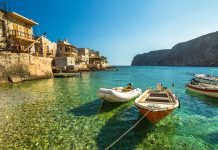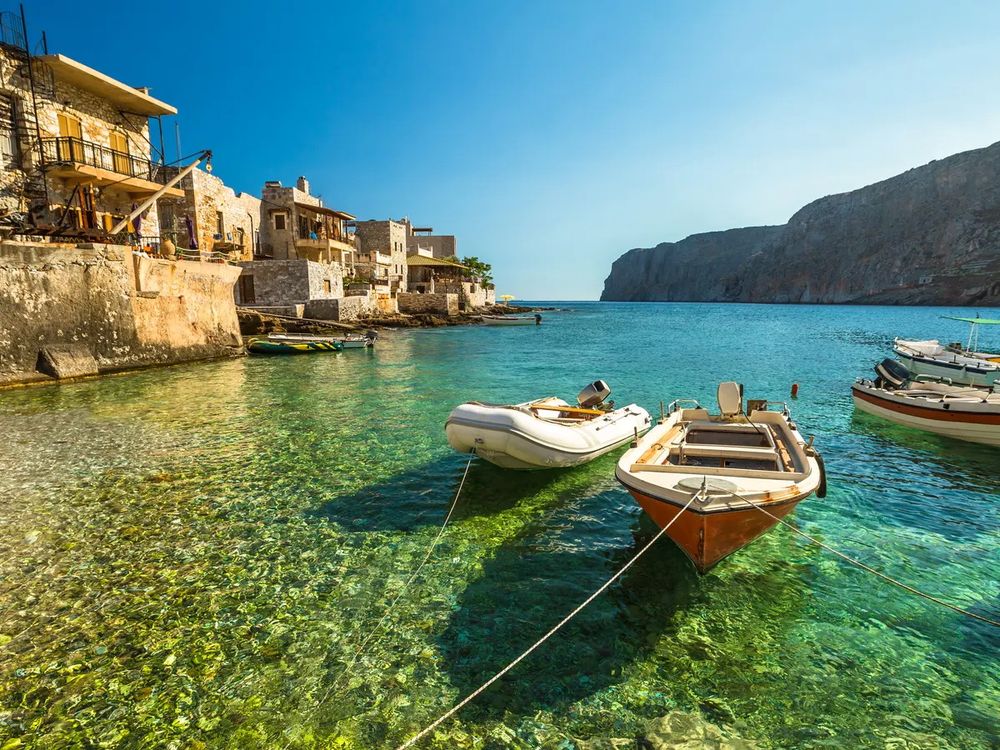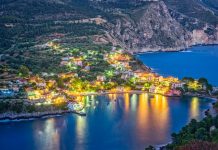The sepulchral monument and portentous sarcophagus of King Frederik V (1723-1766 – ruled Denmark and Norway 1746-1766) – placed in King Frederik Vs Chapel. The two woman statues on each side of the sarcophagus represents Denmark on the left and Norway on the right – and the King is portrayed as a Roman Emperor on the high grey tombstone column. King Frederik V was the founder of noble “Frederikstad” area in Copenhagen and the four Amalienborg Palaces where the equestrian statue of the King is positioned in the octagonal centre of the Royal Palaces.
Roskilde Cathedral – Burial place for Danish Royalties
Roskilde Cathedral was built during the 12th and 13th centuries and incorporates both Gothic and Romanesque architectural design. The Cathedral was Scandinavia’s first Gothic cathedral to be built of brick which encouraged the spread of this style throughout most of Europe.
Roskilde Cathedral in 1750
Roskilde Cathedral in 1750 – seen from north with the old Latin School on the right. The square in front is the market square – where peasants sold there crop and goods. The citizens were use to Royal Burials and processions – as the Cathedral was the final resting place for Danish Kings and Queens since 1536.
Bishop Absalon
Portrait of Bishop Absalon – the founder and Bishop of Roskilde Cathedral – hanging on the wall of the Cathedral and surrounded by the original red bricks from 1170 to 1200. Bishop Absalon was also the creator of Copenhagen around 1167 and Bishop of the Swedish city Lund.
Ancient history
Several wooden churches has been built by a number of Danish Kings on the spot where the present cathedral is placed. The first church was built by King Harald Bluetooth (The King that made all Danes Christian in 965 A.C.) The cornerstones of this splendid twin-spired cathedral was laid by Bishop Absalon – who was the founder of Copenhagen – started the building of the present Cathedral in red bricks around 1170. Since then – various porches and chapels have been added to the main building with different architectural designs representing the best of Danish architecture for more than 800 years and demonstrating the European religious architecture too. Three million fired clay bricks were used to construct Roskilde Cathedral.
A UNESCO historical landmark
Roskilde Cathedral is placed high on a rise and is a historical landmark that can been seen miles away – and nearly every Danes has used the Cathedral as a Milestone with its two cobber plated towers and tall spires. In 1995 the cathedral was included in UNESCO’s list of the world’s inalienable cultural treasures.
The Royal Palace
Roskilde Cathedral is situated in the medieval part of the city and is probably one of the first major buildings on the spot. The yellow buildings around the Cathedral is the former Royal Palace from 1733-76 and called Roskilde Palace. The Palace was used as a stop-over by royal families during Royal Burials.
Royal Burial Plot since 1536
Since the 1536 and after the protestant reformation – Roskilde Cathedral has been the mausoleum and burial place for 40 Danish Kings and Queens. The various ornate sarcophaguses – one more remarkable than the other – are placed in various burial chapels – within and outside the cathedral. Various Chapel sections have been added during centuries to the main building – which has been extended over many generations.
The final resting place
The burial procession of King Fredrik VI (1768-1839 – King of Denmark and Norway 1808-1839) in a cold January day in 1840. His coffin was carried by peasants on their shoulders to the final resting place at Roskilde Cathedral. King Frederik VI – eliminated the abolition of serfdom in 1788.
The funeral procession
The streets of Roskilde in 1906 – where the citizens attended the funeral procession of King Christian IX to Roskilde Cathedral. The King was known as "The father-in-law of Europe" as his children married into other royal houses – and most current European monarchs are descended of him.
The Royal Tombs
The Royal Tombs are spectacular monuments and architectural gems from the time of their period and the portentous sepulchral chapels with the decorated sarcophaguses and Royal coffins have each there own special character and quality – which was created by leading Danish and European architects and the eminent examples of their building ability and architectural skill plus Danish craftsmanship. The Royal Burial plot at Roskilde Cathedral is the only type of sight in the world – where so many Royalties are buried in one place. The Royal Chapels have both monarchs from the Oldenborg and Glücksborg line of Royalties.
The Royal Sarcophaguses
The sarcophagus of Denmark’s first Queen Margrethe I (1353 – 1412) – at Roskilde Cathedral – placed behind the High Altar. She was also Queen of Norway and Sweden – and the founder of the Kalmar Union (1397-1523) that united all of the Scandinavian countries for centuries.
Spectacular Royal Monuments
The pompous burial monument of King Frederik II (King of Denmark and Norway 1559-88) is places in the chapel of the "Holy Three Kings" and beside his father King Christian III burial mausoleum. The monument was created by the Dutch sculptor Geert van Egen from 1594-98.
King Christian IV’s Chapel
The chapel of King Christian IV was completed 6 years before King Christian IV died in 1648. On the wall is a great painting of the King during the battle of Kolberger Heide in 1644 between the Danish and Swedish fleet – where he lost his right eye. His bloody clothes from the battle is exhibited at Rosenborg Castle. King Christian IV (1577-1648 – ruled Denmark and Norway 1588-1648) – is best known as the great builder of Copenhagen. The King died at his beloved Rosenborg Castle in 1648 – and he is buried in a very modest sarcophagus with his rapier sword lying on top of it.
The last Danish Monarch to be crowned
The sarcophaguses of King Christian VIII and his Queen Caroline Amalie. King Christian VIII (1786-1848 – King 1839-1848 of Denmark and King of Norway until 1814) was the eldest son of Hereditary Prince Frederick of Denmark and Norway and Sophia Frederica of Mecklenburg-Schwerin. The King was the philosopher and reformer of the Danish constitution that was carried out by his son King Frederik VII in 1849. King Christian VIII – was the last Danish Monarch to be anointed and crowned as King in 1839 at Frederksborg Castle – as the coronation ceremony was abolished after his succession to the throne.
Altar Piece and interior
The outstanding three-sided altar piece from 1560 was create in Antwerp and is one of the cathedral’s precious artefacts and major attraction. The pulpit was donated by King Christian IV in 1610. The medieval interior such as the great carved doors – paintings and frescoes are ancient relics that are well preserved and a part of the Danish Cultural Heritage as well as the well-preserved historic Raphaëlis organ dated back to the 15th century.
The three-sided Altarpiece
The three-sided altarpiece in Roskilde Cathedral is made in Antwerp around 1560 and is build as a cabinet describing the life of Christ. The pulpit was donated by King Christian IV in 1610.
The organ from 1554
The organ is from 1554 and constructed be the famous Dutch organ builder Herman Raphaëlis Rottensten-Pock and the decorations on the front is in classical baroque style.









